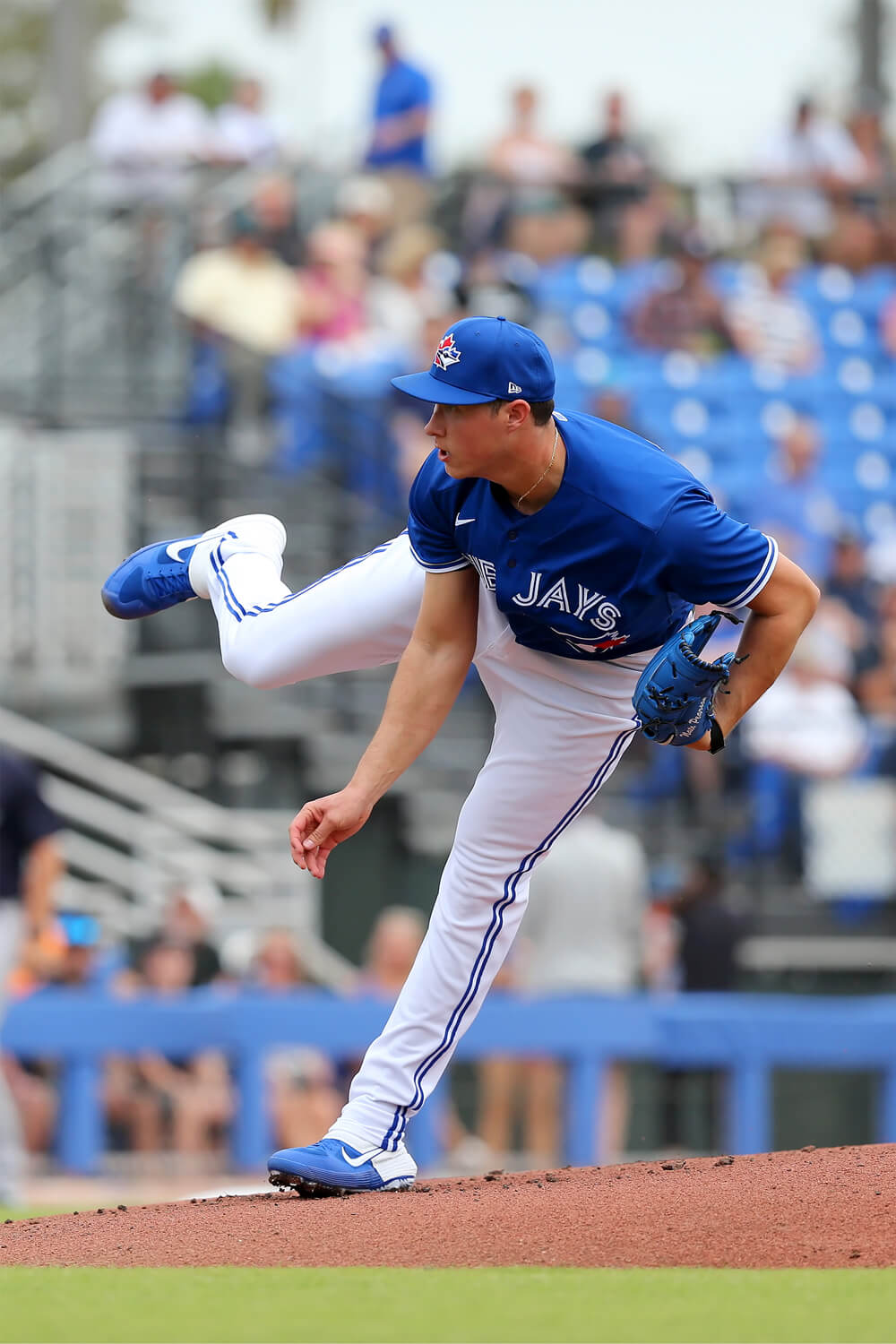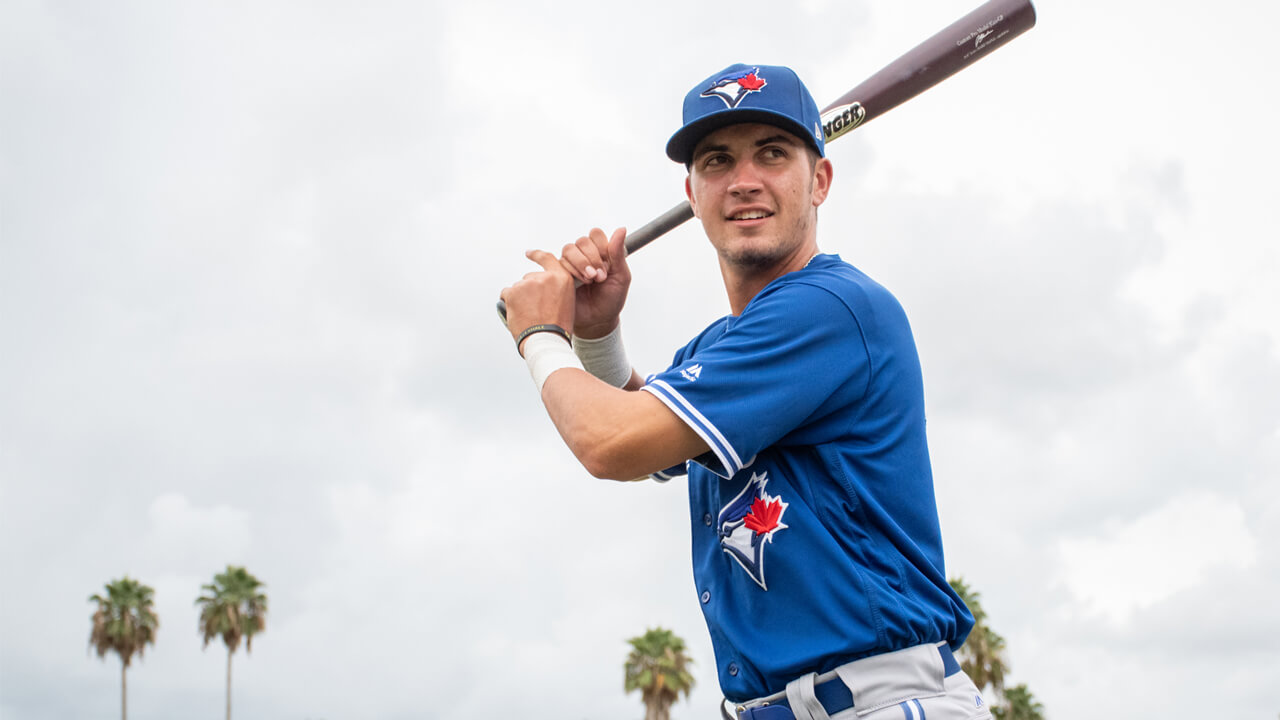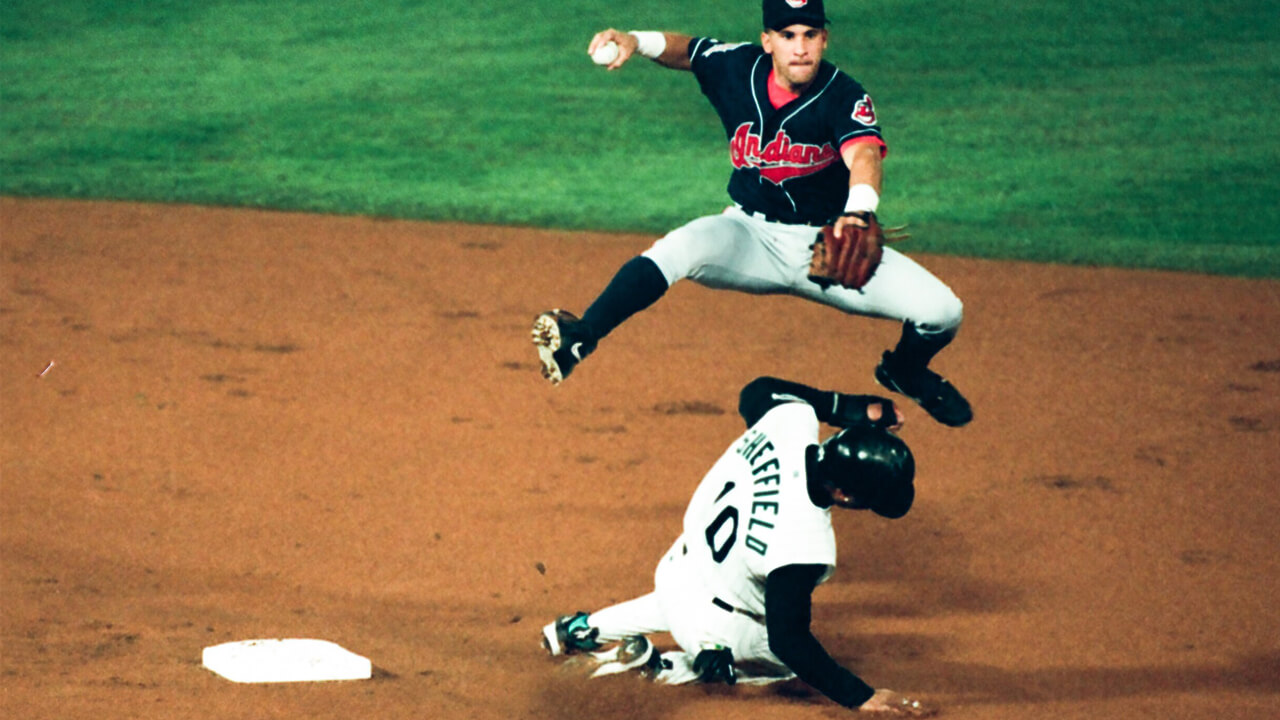Inside a warehouse near the airport in Tampa, Fla., Nate Pearson reaches back, strides forward and releases. His surroundings are utilitarian, but the wood-framed mound simulates game conditions well enough and there’s ample netting nearby to keep baseballs from flying everywhere.
Roughly 2,100 kilometres due north, Dr. Mike Sonne watches on his iPhone as Pearson delivers – and he likes what he sees. It’s not just Pearson holding his attention, though the right-hander does move easily across the screen, with a balanced leg kick followed by a long stride that generates obvious power. It’s also the lines superimposed on the pitcher’s body that Sonne watches. They create a stick figure of sorts, one whose limbs turn from green to orange to red as Pearson delivers. In his role as VP of research and innovation for the baseball tech company ProPlayAI, Sonne has seen more of these animations than anyone. None of them move quite like one Pearson generates.
By now, Pearson was supposed to have joined the major-league staff of the Toronto Blue Jays. He began the year as the best right-handed pitching prospect in baseball and a strong spring training performance was nudging him even closer to the highest level when, in March, the COVID-19 pandemic shut down the season before it began.
Since then, baseball players at all levels have faced a problem that was nearly unthinkable a few months back: how to improve when there’s next to no access to club facilities or opponents? For players, the answer to this riddle matters immensely, since the difference between improving and stagnating could also be the difference that lands them more playing time or a new contract.
In Pearson’s case, his first big-league roster spot may soon be at stake, and if there’s an edge available that can help him lock it down, he wants to find it. With that in mind, he’s not only using technology, he’s helping create it. Along with Sonne, he’s one of ProPlayAI’s three co-founders, and today’s session is part of the final tune-ups before the biomechanics company makes its product publicly available for the first time.
Their project is just part of a bigger picture emerging around baseball. During quarantine, while much of the outside world has slowed down, staff and players across the game have relied more heavily than usual on baseball’s emerging technology and analytics to seek advantages over the competition. Even in isolation, there will be winners and losers – we just won’t know who’s who until play resumes.
“The people who are involved in technology in baseball are cutting-edge, innovative people no matter what,” Sonne says from his home in Hamilton, Ont. “You could stick those people in a subarctic research station and they’d still find a way to capture spin rate on a snowball.”
If anyone could measure the spin rate on a snowball, it’s Seth Daniels. He could also tell you the snowball’s spin efficiency, spin direction, gyro degree and release angle in fairly short order. Daniels, a former college pitcher, is now the director of diamond sports for Rapsodo, the company responsible for the tracking devices that have allowed players to measure their progress with ever-increasing precision.
As recently as 2017, just a handful of big-league teams owned one of the compact black boxes that sit in front of home plate and use a combination of radar and cameras to track pitches with incredible precision. By 2020, all 30 teams were on-board — and so were 80 per cent of Division 1 colleges. In other words, Rapsodo went from cutting edge to table stakes within three years.
Then, in March, everything changed in a whole new way. Just as teams were nearing the end of spring training, the coronavirus pandemic pushed everyone back into off-season mode. Suddenly, players had to find ways to stay in shape — and track their development — without the benefit of the facilities they’d normally rely on. With social distancing essential, technology had to help close the gap. It didn’t take long for Rapsodo to start getting calls from pro players looking to train in their garages and backyards. Within the first few months of quarantine alone, nearly 100 pros ordered the devices for personal use.
“We’ve sold probably more to MLB players in the last three or four months than we had in the past year,” Daniels says.
Around baseball, players aren’t the only ones adjusting to the challenges posed by the pandemic. Within front offices, executives have more time on their hands than ever, and many of them are turning to Rapsodo in another way.
On its own, the data from a bullpen or hitting session isn’t much more than a bunch of interesting numbers. The real edge comes in understanding and applying this information in a practical way, something that demands understanding. With that in mind, the idea of a certification course first surfaced at Rapsodo four or five years ago. By coincidence, Rapsodo’s hitting certification course launched just before the league shut down. Six weeks later, its pitching counterpart followed.
In the few months since, over 1,000 MLB coaches and front office members have completed the courses. The Tigers alone have had 147 employees take part, and every front office in baseball has had at least one employee earn the certification. Along the way, knowledge that was typically limited to one or two coaches per organization a few years ago has quickly become widespread. That was likely inevitable regardless of when the course launched, but without games, the appetite for Rapsodo’s material may be even greater. And with each new graduate of the course, the Rapsodo vocabulary becomes further entrenched in the baseball conversation.
“It’s pretty incredible,” Daniels says. “People were at home and needed something to do. I know a lot of our MLB partners were very happy that we had that continued education.”

They weren’t the only ones. I’ve watched with curiosity as the thinking around player development has become increasingly data-driven in recent years. A couple springs ago, when Rapsodo’s small, black tracking devices started popping up on backfields throughout the Grapefruit League, I couldn’t help but notice, and I wondered how all that data connected to the games I watched every night.
But it’s one thing to be aware of these changes, and another to take a real crack at understanding them. So when Rapsodo’s pitching certification course launched and I was offered the chance to take it, I dove deep into the world of frisbee change-ups, glove-side run and pitch fitting. Going in, I expected a challenge — the course is geared toward coaches and front office members, after all — but even then I didn’t fully anticipate the level of precision involved. The experience that followed was both eye-opening and humbling.
For instance, most baseball fans have heard of spin rate by now — it’s on national TV broadcasts and easy to find online. But at Rapsodo there’s topspin, backspin, sidespin and even gyrospin, the football-like rotation that makes Dylan Bundy’s slider so effective. Once you know those variables you arrive at spin efficiency — how much of the spin is contributing directly to the movement of the baseball — and spin direction. Before long, it starts to feel like pitchers have 25 pitches to choose from instead of just five or six.
But of course, identifying pitches on a screen only gets you so far. In a game setting, pitchers need tools and tricks to keep hitters off-balance, so the way these pitches relate to one another is critically important. Spin is essential for nearly all pitches, but gaining more rpm is easier said than done. That means pitchers must make the most of what they have, tinkering with their offerings to ensure they complement each other in a practice called pitch design that’s been embraced by the likes of Trevor Bauer and Adam Ottavino.
The goal is to move away from a one-size-fits-all model and create pitches that work together based on individual pitchers’ mechanics and pitch profiles. That’s why reading the data from a Rapsodo unit only gets you so far. The sidespin slider that works so well for Ottavino isn’t for everyone. By analyzing data collected from hundreds of professional pitchers, Rapsodo can now outline a path tailored to the individual.
In theory, at least. Even after completing the course, I’m not going to pretend I can tell you the optimal spin efficiency for a slurve without looking up the answer. And there’s certainly no way I’d feel comfortable telling a pitcher what to throw. But by spending a couple days learning the same language spoken by those developing tomorrow’s pitchers, I got a clearer sense of what pitching instruction and development looks like in today’s game.
For the likes of Matt Buschmann, the concepts and numbers I found so challenging are part of everyday life. Buschmann, the Blue Jays’ director of pitching development and major-league bullpen coach, was pitching in the big-leagues as recently as 2016. In the four years since, the 36-year-old has transitioned to coaching, where he works closely with pitching coach Pete Walker and rehab pitching coordinator David Aardsma to apply these concepts where it counts most.
Even amidst the organized chaos of the regular season, pitching coaches rely on analytics constantly. Yet in recent months, the Blue Jays have leaned on technology in ways they typically wouldn’t. Often, that’s something as simple as Zoom calls, which allow coaches to stay in touch with players from afar — and even share screens to discuss specifics like grips and release points. “I can show [a pitcher] video. I can show him data,” Buschmann said when he joined Arden Zwelling and me on the At the Letters podcast last month. “To basically feel like you’re sitting next to a player even though he’s wherever else in the world? Man, that’s been pretty cool. It almost makes it better. Because when you’re [having those discussions] on the field sometimes, you don’t have that [visual] to pull from.”
Plus, technology can be especially powerful when paired with extra time to apply it. In the course of a 162-game season, results are the top priority; tinkering can get in the way. Since the onset of the pandemic, players have had time to indulge in deep dives that wouldn’t typically be possible. As Buschmann says, “The season coming up is just this oncoming train that you can’t ignore. This time has allowed us to really dive a little bit deeper into these areas and really clean them up.”
In a way, these discussions have been years in the making for the Blue Jays. A few seasons ago, when Rapsodo was first starting to gain recognition and Aardsma was hoping to prolong his big-league career, he ordered one of the first few dozen pitching monitors the company sold. Then, two springs ago, general manager Ross Atkins hired Aardsma in the hopes that his knowledge could help guide the organization forward.
Now, Aardsma’s one of the many people charged with developing the organization’s young pitchers — and the longer the pandemic continues, the more essential their collective work becomes. Already, the staff has had to innovate. For example, pitching analysis coordinator Matt Tracy has been doing delivery assessments via remote video, while pitching programs coordinator Corey Popham has been helping pitchers use Motus sleeves to track their at-home workload.

Beyond pitching, the Blue Jays have programmed their own online exercises designed to develop decision-making at the plate and in the field. Hitters can log in to work on pitch recognition, catchers can practice game-calling and infielders can build in-game awareness by anticipating batted balls depending on the count or the batter’s swing path.
But of everyone in the Toronto organization, it’s Pearson who’s best-equipped to turn all of that knowledge into results on the field. With the support of those around him, Pearson could eventually be a frontline starter for 200 innings per season, with the added ability to alter the fate of a seven-game playoff series.
That’s what makes his buy-in here so intriguing. Given his potential impact, few would push back if he preferred an old-school approach that eschewed data. Instead, Pearson describes himself as someone who’s always trying to learn, and he practices what he preaches. Whoop sensors track his heart rate, Catapult wearables monitor his workload and Rapsodo devices provide instant feedback after each side session. If there’s a resource out there, he wants to know about it.
In years past, Pearson’s search for improvement has taken him to Driveline, the data-driven baseball training facility led by analytical guru Kyle Boddy. But in recent months, those trips haven’t been an option for players as Driveline has shifted most of its operations online out of concern for health and safety. In Toronto, the Baseball Development Group did the same. For minor-league players without the means to buy their own technology or the space to use it, this poses a real obstacle. By the time Driveline’s Washington and Arizona facilities reopen in June, they will have been closed for nearly three months. During that time, the gap will have widened between those with access to the necessary technology and those without it.
Still, for the players, coaches and executives who can use the equipment, the work continues in isolation. For Pearson, that means an extended stay in Florida and a delayed MLB debut. But if nothing else, he’s seeking out ways to improve by diving even further into the world of baseball tech.
“It’s kind of serendipitous that it’s a guy who will be in Toronto, hopefully sooner rather than later,” Sonne says.
Despite the ongoing pandemic, ProPlayAI has built considerable momentum in recent months. In April, Pearson officially joined the company thanks to a connection with Casey Mulholland, a former minor-league pitcher who’s now the director of the KineticPro training facility Pearson uses in Tampa. Since then, Pearson has been able to offer Sonne input on what works best for him from the perspective of an elite pitcher. And lately, Pearson has been more available than he would be during the grind of the regular season, with calls or Zoom sessions taking place every couple of weeks.
There’s certainly no shortage of ground to cover when it comes to integrating biomechanics and baseball. For years, scouting reports have included phrases like ‘long arm action’ and ‘short stride’ but those phrases can mean different things to different people. ProPlayAI has some familiar goals in mind — to limit injuries and help players perform better — but its conclusions are based on data, rather than conjecture. While the data captured doesn’t rival the level of detail you’d get in a lab, it’s available to anyone with a smartphone. Sometimes it’s preferable to have 85-per cent accuracy 85 per cent of the time than 100-per cent accuracy one per cent of the time.
“Biomechanics labs are always going to be your gold standard,” Sonne says. “But chances are you probably don’t have one of those out in the Dominican, when there may be someone throwing 97 and you want to analyze their mechanics.”
That data is especially useful at a time when teams are looking far beyond results-based stats like ERA, because the motion leading to those results is more predictive and therefore more important. That’s why more than a dozen clubs have already expressed interest in working with ProPlayAI, and why Driveline recently completed a deal with the emerging platform.
“It’s not perfect when you compare it against motion-capture,” Sonne notes, “But it’s way better than the naked eye.”
It all contributes to the ever-growing, increasingly indispensable baseball tech world. Eventually, though, the current stoppage will end and the sport will return. When it does, Pearson will have less time for Zoom consultations, Buschmann will have fewer hours to devote to pitch design and Daniels may have fewer players requesting hardware. But the world they return to will be impacted in a lasting way despite the lack of games played. If anything there’s been more innovation than usual during quarantine, and much of it looks to be here to stay.



